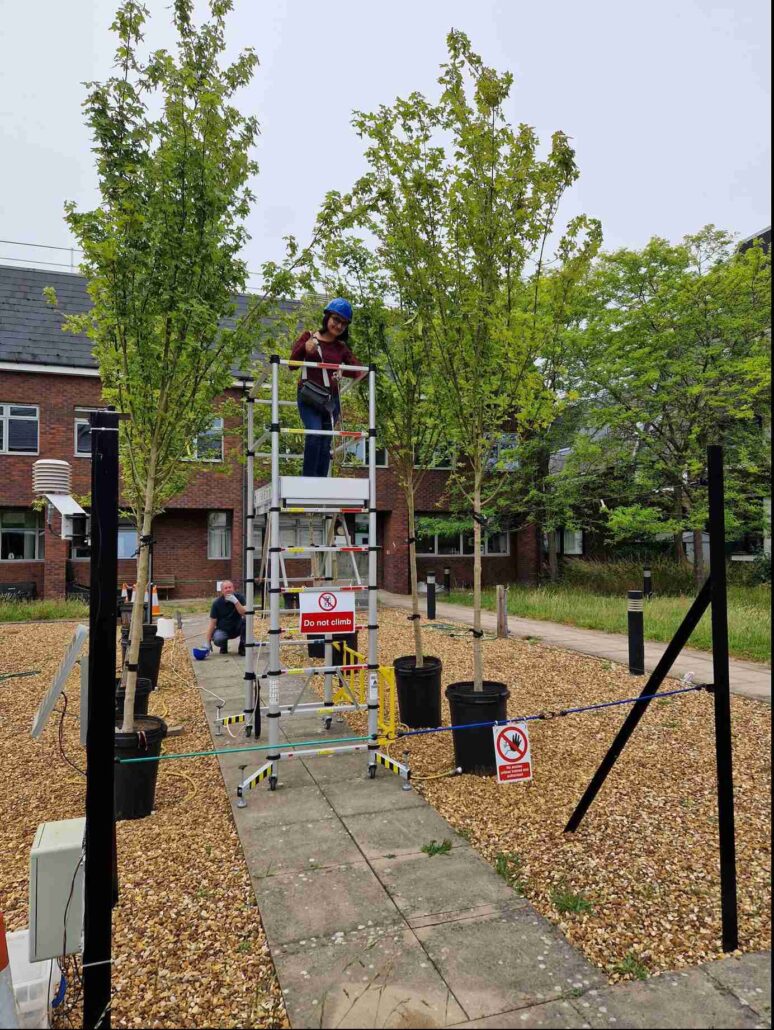
Investigating the effects of temperature extremes on urban trees
By Ramla Khan, PhD Student, Environment, Earth and Ecosystem Sciences (EEES), The Open University.
Urban trees play a vital role in enhancing the cultural and ecological environment of cities globally. Tree planting is a vital tool in progress on sustainability in cities worldwide. As well as greatly enhancing the aesthetics of a place, trees also support and enhance the mental and physical well-being of those who reside in the city, offering green vistas, and spaces for recreation and relaxation. Trees provide substantial benefits that are crucial for urban ecosystems: trees act as natural air purifiers, mitigating pollution by absorbing harmful gases and particulate matter while releasing oxygen for us to breathe. They also sequester carbon dioxide, older and larger trees absorb more than smaller and younger trees. Very importantly, trees have been shown to reduce urban heat effects through shade and evapotranspiration (moving water into the atmosphere). As we see global temperatures rise, urban trees can play a critical role in regulating temperatures in cities around the world and making them habitable places. Additionally, urban trees foster biodiversity, providing habitat for urban wildlife.
The significance of trees in urban environments is widely acknowledged. However, escalating global temperatures resulting from climate change pose a significant threat to many species of trees in cities, especially those being newly planted as part of sustainability activities. With increasing temperature ranges and extreme weather patterns, many urban trees struggle to thrive and mature to sequester carbon at the rates we need.
Open University doctoral researcher, Ramla Khan has delved into this pressing issue, examining the repercussions of rising temperatures and heatwaves by studying the effects of climate change on trees in Milton Keynes.
Using Treezilla, a citizen science tool that collects data from the public on the location of various tree species and genus in the UK, 7,750 trees were found to be mapped in Milton Keynes. This includes 200 of the most common tree species found in the UK: Acer Campestris Elegant (Field Maple). The Open University campus is now the site of a controlled set-up comprising eight Acer Campestre trees housed in 90-liter pots, alongside a reservoir tank equipped with a float chamber and mesocosms to enable the collection of physiology data from the trees and illustrate the impact of the frequent and intense heatwaves of 2022 on the physiological functions of the tree specimens.

In addition, data from Sentinel-2 satellite imagery (Google Earth) enables examination of the city’s treescape and plotting of the effects of weather conditions on the health status of the city’s trees, in particular, the 200 Field Maple. In the spatial maps generated, the effects of temperature rise on the city’s trees is clearly visible in browning effects and stress. In 2018, the four heatwaves of that year are visible in this way and during those months when the trees were impacted, they were struggling to produce all the wonderful benefits outlined above. In addition, we don’t know the long-term impact of regular heat stress on the maturity and life-span of urban trees.
The effects of climate change are leading to rising temperatures and weather extremes which mean that many recently planted native trees in urban areas will struggle to cope with the stress. Trees are such a vital part of urban life, and this research intends to inform city planners, landscapers and developers so that they can think long-term about the species of trees they are planting and how they respond to climate extremes. Sadly, many of the native species we currently plant may not bring the benefits we are counting on in later years in a changing climate. The good news is that different tree species have different resilience levels in response to extreme temperatures, so we are starting to be able to specify species more likely to be resilient to predicted climate impacts.
Knowledge is key and one of the ways we can all play our part is through becoming a citizen scientist and using Treezilla to map our local trees and make the information openly available. There is a fascinating variety of urban trees in the UK and Ireland, however knowledge of what they are and where they are is poor. There may be as many as 1.5 billion urban trees in the UK, but fewer than ten percent are recorded in databases. A much smaller percentage are available in open and online information for the public – the most common example is through local authority Tree Preservation Orders. By open mapping the UK’s urban trees, we can understand more about where our trees are at risk and help produce strategies to combat rising temperatures and help our trees continue their vital work.
Treezilla is an ambitions project to map all of Britain’s trees and record vital data about tree disease and the environmental benefits that trees provide. It is a platform for a wide range of enquiry-led scientific investigations using real data from trees.
Why not map the trees near your business, near your work, in your garden, street or playground and upload photos or simply browse the trees in your area?
To find out more, log onto www.treezilla.org – you may also be interested in the guided activities that we have available for Treezilla in The OpenScience Laboratory.
To find out more about collaborating on our sustainability-related research, please visit Open Societal Challenges.
Author’s Biography
Ramla Khan, PhD Student, Environment, Earth and Ecosystem Sciences (EEES), The Open University.
My research focus is global natural disaster mitigation using Geographic Information Systems (GIS) and Remote Sensing (RS). I worked on droughts at the Space Technology Institute, and on earthquakes, landslides, and urban floods at the National Center of Artificial Intelligence, both in Islamabad, Pakistan.
Presently, I am finalising my PhD submission on assessing the ramifications of extreme heat on urban tree populations. My research pursuits intersect the domains of climate change, machine learning, environmental science, remote sensing, and GIS, reflecting a profound commitment to advancing knowledge in these critical areas to mitigate and manage the impacts of climate change.